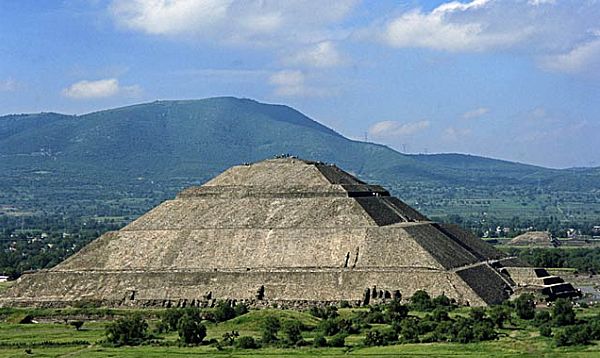Teotihuacan, Mexico - In a recent study from the National Autonomous University of Mexico (UNAM) lead by physicist Dr. Arturo Menchaca, it was discovered that the soil beneath the south side of Mexico's largest pyramid was severely dry, putting it at risk of collapse like a sandcastle lacking enough water.
Originally, Menchaca and colleagues set out to find and record a series a secret underground tunnels in the pyramid, similar to those found under the neighboring Pyramid of the Moon, by using a muon detector. Muons are sub-atomic particles that pass through most materials, but are sometimes deflected by more dense objects. This way, they can detect if there is less dense air, less dense earth, caves, etc., underground. They could even create a 3D image of the underground passageways that they thought existed under the pyramid.
But, what they found was shocking.
"Our scans show that the pyramid is dryer on one side than in the other," said Menchaca, "the dry part is very large, with about 10 percent of its volume exceedingly dry due to an excessive exposure to the sun's rays."
The pyramid has actually not been expose to the sun that long - despite its name. It was only in 1910 that the pyramid was restored and made to look as it is now, exposing it to the sun after centuries of being kept moist under a layer of soil, vegetation, and rock.
Menchaca used the sandcastle analogy to describe what is happening to the pyramid. "Its basically been left abandoned to the sun, much like how a sandcastle collapses if not kept moist. Most of Mesoamerica's structures are built from rock and earth," he said.
Dr. Menchaca suggests wetting the dry side to prevent a collapse - but not every archaeologist agrees with his theory.
"The real problem may be excess water, not dryness," says Alejandro Sarabia, the site director at Teotihuacan. "Decades ago, cement was added between the covering stones. This added stability and hindered the growth of vegetation. On the other hand, it prevents the evaporation of humidity created by water seeping through gaps."
UNESCO has actually cited the cement and other previous restoration attempts - together with the construction of a Walmart near the site - as a threat to its status as a world heritage site.
Sarabia says archaeologists are now replacing the cement with more suitable materials like river sand.
A report by UNAM says that they are currently considering possible solutions for preventing a collapse or damage to this important heritage site. Although they still have only analyzed 60 percent of the data collected by the scan, they project to be fully deliberated by the end of the year.
Original Story


